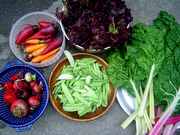

|
| Vegetable Varieties for Gardeners is a citizen science program
|
|
|
|
'Nickel' Beans |
| |
| Sub-Category: |
Bush
Green
|
| |
|
| Sub-Category 2: |
| | Description: |
Bush green/French filet bean with 4 1/2-inch, stringless, dark-green pods with slowly developing white beans. Resistant to anthracnose, bacterial brown spot and common bean mosaic.
|
| Days To Maturity: |
52-59
|
| Seed Sources: |
Underwood Gardens - updated in 2011
|
| |
| Rating Summary |
| |
Overall: (4.2 Stars)
Taste: (4.8 Stars)
Yield: (4.0 Stars)
Ease/Reliability: (4.0 Stars) |
| |
| Reviews |
| |
Login to share your Review of Nickel.
Number of Reviews: 4
KEY: O=Overall Rating, T=Taste, Y=Yield, E=Ease
Reviewed on 07/21/2006 by
bugsy
- An intermediate gardener
|
 Overall Overall
 Taste Taste
 Yield Yield
 Ease Ease
|
Orange, California, United States
Frost Free Season: More than 203 days
Soil Texture: Clay
Garden Size: Small - Less than 400 square feet (20' x 20')
Sun Exposure: More than 8 hours per day
|
| This was the first haricot vert type of green bean I grew. It produced one large flush of relatively straight and good tasting beans then a smaller one. I grew these under my tomato plants which was good because the tomato plants protected them from the extreme heat. All in all, a good bean to try. |
| |
|
Reviewed on 05/01/2005 by
California Olive
- An experienced gardener
|
 Overall Overall
 Taste Taste
 Yield Yield
 Ease Ease
|
California, United States
Frost Free Season: More than 203 days
Soil Texture: Clay
Garden Size: Large - More than 1,600 square feet (40' x 40')
Sun Exposure: More than 8 hours per day
|
| Nickel is described as being tolerant of hot conditions. It may be more heat-tolerant than older filet types. It does much better in heat than the pole filet variety Emerite, for example, which delivers only hollow, leathery husks in hot weather. But I have not found it to be as heat-tolerant as Maxibel, a longer filet type which grows on a slightly more vigorous plant.
Nickel would probably be fine in most climates, but here the beans toughen and the plants seem to lose vigor when temperatures go into the high nineties. Maxibel can deliver good beans even when temperatures inch above100 degrees, though they curl a little in the heat.
Most varieties of P. vulgaris which can produce good beans here even when there are spells of hot weather up to about 105 degrees (with cool nights) are "concentrated set" varieties which do not give an extended harvest. One example would be Brio. |
| | | 1 of 1 gardener found this review helpful.
|
|
Reviewed on 12/15/2004 by
BPippin
- An experienced gardener
|
 Overall Overall
 Taste Taste
 Yield Yield
 Ease Ease
|
Ontario, New York, United States
Frost Free Season: 143 - 163 days
Soil Texture: Loam
Garden Size: Large - More than 1,600 square feet (40' x 40')
Sun Exposure: 6 to 8 hours per day
|
| This is my favorite bush bean variety. It is a French file type, so is best picked young and tender. Yields have been good and the taste is delicate. Just right for a main dish or as a side dish to meat or seafood. If you need to bring a "dish to pass" at the church supper , you might try a blue lake variety and save these for yourself! |
| |
|
Reviewed on 09/16/2004 by
George Morrison
- An experienced gardener
|
 Overall Overall
 Taste Taste
 Yield Yield
 Ease Ease
|
Westchester, New York, United States
Frost Free Season: 163 - 183 days
Soil Texture: Clay
Garden Size: Medium - 400 square feet to 1,600 square feet
Sun Exposure: Less than 6 hours per day
|
| If I had only one bean variety to grow, I would choose Nickel over all the others. Fans of Blue Lake and Romano types will argue vigorously with me, but space in my modest sized garden forces me to limit my choices. This French filet bean is best eaten when very young and slim. The beans have excellent flavor and would be the green bean to serve at an elegant dinner. If the beans are picked every other day, the yields can be very good. I have even cut the plants back after the first flowering and been surprised by a second flush of fine quality beans. Be aware that the seeds are white and small and prone to rot in cool, moist soils. Wait until the soil has warmed before planting. |
| |
|
|
|
|
Vegetable Varieties for Gardeners is a citizen science program, © 2004-2024, All Rights Reserved
Cornell Garden Based Learning, Cornell University College of Agriculture & Life Sciences, Horticulture Section
|






 VVfG home
VVfG home
 Taste
Taste Overall
Overall